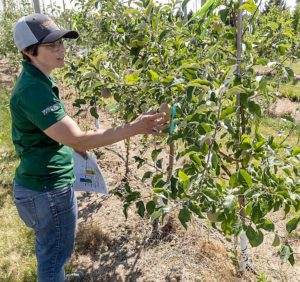
Over the past 50 years, we’ve seen apple orchards change dramatically, from low-density plantings where each tree has a unique canopy structure, to high-density plantings with the canopy simplified and constrained to a narrow, flat “fruiting-wall” or “planar” system. These changes have significantly improved yield per acre for apple. However, over that same time period, peach production systems, and yield per acre, have remained largely the same.
At Michigan State University, we’ve been investigating new genetic and training strategies to grow peaches in planar systems. Specifically, we are working to identify ways to reduce labor associated with fruiting-wall systems and ways to keep a peach tree small enough for a high-density planting.
Our training methods for this study include one three-dimensional and three planar systems developed by Michigan State University tree physiologist Greg Lang for sweet cherry:
—The first planar system is a high-density super slender axe (SSA) system, with trees planted in a 3-foot by 12-foot spacing, maintained as a single leader and trellised with Ag-Liner plastic filament. (All three planar systems use Ag-Liner plastic filament for trellis wire, to avoid bark injury.)
—The second planar system is a trellised dual-leader, dual SSA method, with a 6-foot by 12-foot spacing.
—Third is the Upright Fruiting Offshoots (UFO) method, where six to eight leaders grow from a horizontal dual cordon at an 8-foot by 12-foot spacing.
—For a three-dimensional control for the study, we are using a four-leader quad SSA training style, similar to an open-vase system, with an 8-foot by 12-foot spacing.
The cultivars we are using are Bounty, Sweet-N-UP and Crimson Rocket, three yellow-fleshed, freestone peaches bred by Ralph Scorza at the U.S. Department of Agriculture Appalachian Fruit Research Station in Kearneysville, West Virginia. All are grafted onto nondwarfing rootstocks. Bounty has a standard spreading canopy shape, while Sweet-N-UP exhibits an upright shape and Crimson Rocket has a pillar shape. Our research program also studies the gene that controls these architectural differences — to help us develop additional strategies for controlling canopy shape.
The goals of this study are twofold. First, we want to test the ease of implementing these training styles to create fruiting walls using a common commercial variety. Second, we are assessing if there are advantages to using varieties with more slender growth habits in planar training systems. If one of these nonstandard growth architectures proves to be beneficial for planar fruiting-wall systems or high-density systems, breeders can use these existing upright and pillar cultivars in their programs and select for narrower architectures.

Early orchard yields (fourth leaf and fifth leaf) suggest that UFO trees with six to eight leaders and an 8-foot in-row spacing can produce yields similar to a high-density SSA system with one leader per tree at 3-foot in-row spacing. Further, both these training styles were better yielding than our three-dimensional quad SSA trial, and there was no difference in fruit quality among the training styles we trialed.
While our study is not yet complete, the data so far suggest that increasing leader number per acre, rather than trees per acre, may be one solution to achieving high-density yields without having to constrain numerous large trees to an unrealistically small space. We’re looking forward to seeing if that remains true over the productive lifespan of the orchard. This result is similar to what Lang found with his nectarine trials at the MSU Southwest Michigan Research and Extension Center in Benton Harbor.
Additionally, when trained in the UFO style, the upright architecture of Sweet-N-UP provided a nice balance between filling the space quickly (which was a challenge for the pillar architecture) and keeping fruiting wood close to the leader (which was a challenge for the standard architecture). In contrast, Bounty trees, with the standard spreading architecture, had more of a uniform fruit distribution than the upright and pillar trees when grown as a single or dual leader. Essentially, the ideal tree shape may vary depending on the training system implemented.
This work is still in the beginning stages. The majority of the Hollender lab’s research is focused on how plants determine and regulate their architecture at the molecular level. We hope our field and lab studies together will guide cultural practice development and assist breeders in making intentional selections for beneficial differences in tree structure. We’re committed to blending basic and applied research to develop practical solutions to make fruiting-wall production systems a viable and profitable commercial option for peach and other stone fruit growers.
This project is funded by the USDA North Central Region Sustainable Agriculture Research and Education program graduate student award, the Michigan State Horticultural Society and MSU AgBioResearch Project GREEEN.
—by Andrea Kohler and Courtney Hollender
Andrea Kohler is a doctoral graduate student and research assistant at Michigan State Univeristy, and Courtney Hollender is an assistant professor in the MSU department of horticulture who studies plant development and fruit tree physiology.
Share your thoughts

The Michigan State University research team would like to hear from growers regarding their experiences with and concerns about planar training systems for peach. To that end, they developed a short and anonymous survey seeking input to guide future research. If you are a peach grower who can spare a few minutes, please go to: bit.ly/msu-peach-survey or scan the QR code.








Leave A Comment